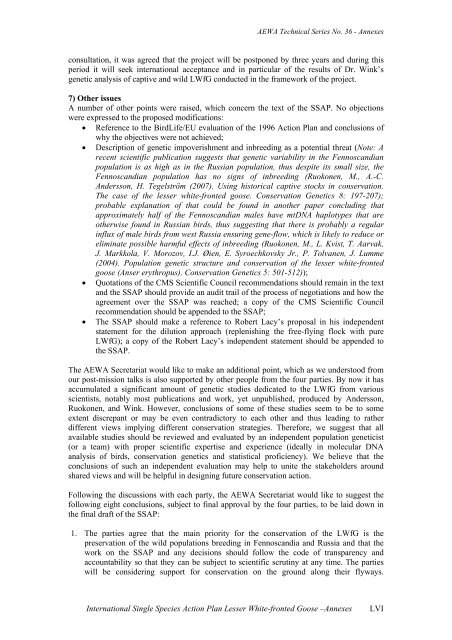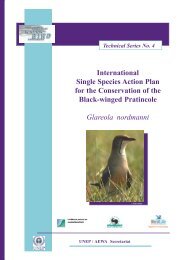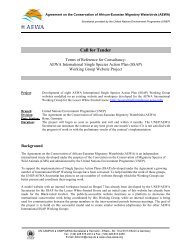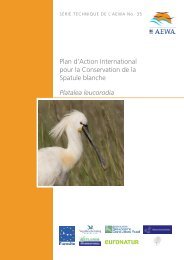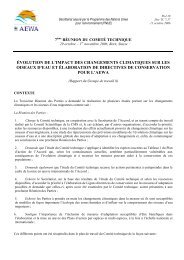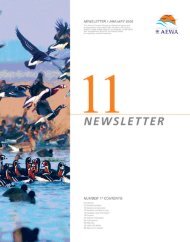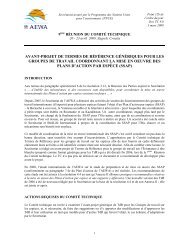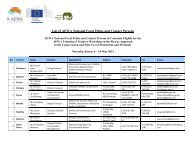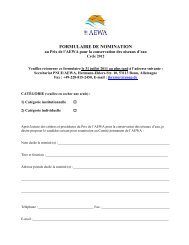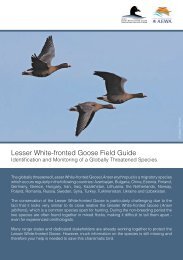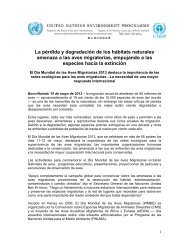International Single Species Action Plan for the ... - AEWA
International Single Species Action Plan for the ... - AEWA
International Single Species Action Plan for the ... - AEWA
You also want an ePaper? Increase the reach of your titles
YUMPU automatically turns print PDFs into web optimized ePapers that Google loves.
<strong>AEWA</strong> Technical Series No. 36 - Annexes<br />
consultation, it was agreed that <strong>the</strong> project will be postponed by three years and during this<br />
period it will seek international acceptance and in particular of <strong>the</strong> results of Dr. Wink’s<br />
genetic analysis of captive and wild LWfG conducted in <strong>the</strong> framework of <strong>the</strong> project.<br />
7) O<strong>the</strong>r issues<br />
A number of o<strong>the</strong>r points were raised, which concern <strong>the</strong> text of <strong>the</strong> SSAP. No objections<br />
were expressed to <strong>the</strong> proposed modifications:<br />
• Reference to <strong>the</strong> BirdLife/EU evaluation of <strong>the</strong> 1996 <strong>Action</strong> <strong>Plan</strong> and conclusions of<br />
why <strong>the</strong> objectives were not achieved;<br />
• Description of genetic impoverishment and inbreeding as a potential threat (Note: A<br />
recent scientific publication suggests that genetic variability in <strong>the</strong> Fennoscandian<br />
population is as high as in <strong>the</strong> Russian population, thus despite its small size, <strong>the</strong><br />
Fennoscandian population has no signs of inbreeding (Ruokonen, M., A.-C.<br />
Andersson, H. Tegelström (2007). Using historical captive stocks in conservation.<br />
The case of <strong>the</strong> lesser white-fronted goose. Conservation Genetics 8: 197-207);<br />
probable explanation of that could be found in ano<strong>the</strong>r paper concluding that<br />
approximately half of <strong>the</strong> Fennoscandian males have mtDNA haplotypes that are<br />
o<strong>the</strong>rwise found in Russian birds, thus suggesting that <strong>the</strong>re is probably a regular<br />
influx of male birds from west Russia ensuring gene-flow, which is likely to reduce or<br />
eliminate possible harmful effects of inbreeding (Ruokonen, M., L. Kvist, T. Aarvak,<br />
J. Markkola, V. Morozov, I.J. Øien, E. Syroechkovsky Jr., P. Tolvanen, J. Lumme<br />
(2004). Population genetic structure and conservation of <strong>the</strong> lesser white-fronted<br />
goose (Anser erythropus). Conservation Genetics 5: 501-512));<br />
• Quotations of <strong>the</strong> CMS Scientific Council recommendations should remain in <strong>the</strong> text<br />
and <strong>the</strong> SSAP should provide an audit trail of <strong>the</strong> process of negotiations and how <strong>the</strong><br />
agreement over <strong>the</strong> SSAP was reached; a copy of <strong>the</strong> CMS Scientific Council<br />
recommendation should be appended to <strong>the</strong> SSAP;<br />
• The SSAP should make a reference to Robert Lacy’s proposal in his independent<br />
statement <strong>for</strong> <strong>the</strong> dilution approach (replenishing <strong>the</strong> free-flying flock with pure<br />
LWfG); a copy of <strong>the</strong> Robert Lacy’s independent statement should be appended to<br />
<strong>the</strong> SSAP.<br />
The <strong>AEWA</strong> Secretariat would like to make an additional point, which as we understood from<br />
our post-mission talks is also supported by o<strong>the</strong>r people from <strong>the</strong> four parties. By now it has<br />
accumulated a significant amount of genetic studies dedicated to <strong>the</strong> LWfG from various<br />
scientists, notably most publications and work, yet unpublished, produced by Andersson,<br />
Ruokonen, and Wink. However, conclusions of some of <strong>the</strong>se studies seem to be to some<br />
extent discrepant or may be even contradictory to each o<strong>the</strong>r and thus leading to ra<strong>the</strong>r<br />
different views implying different conservation strategies. There<strong>for</strong>e, we suggest that all<br />
available studies should be reviewed and evaluated by an independent population geneticist<br />
(or a team) with proper scientific expertise and experience (ideally in molecular DNA<br />
analysis of birds, conservation genetics and statistical proficiency). We believe that <strong>the</strong><br />
conclusions of such an independent evaluation may help to unite <strong>the</strong> stakeholders around<br />
shared views and will be helpful in designing future conservation action.<br />
Following <strong>the</strong> discussions with each party, <strong>the</strong> <strong>AEWA</strong> Secretariat would like to suggest <strong>the</strong><br />
following eight conclusions, subject to final approval by <strong>the</strong> four parties, to be laid down in<br />
<strong>the</strong> final draft of <strong>the</strong> SSAP:<br />
1. The parties agree that <strong>the</strong> main priority <strong>for</strong> <strong>the</strong> conservation of <strong>the</strong> LWfG is <strong>the</strong><br />
preservation of <strong>the</strong> wild populations breeding in Fennoscandia and Russia and that <strong>the</strong><br />
work on <strong>the</strong> SSAP and any decisions should follow <strong>the</strong> code of transparency and<br />
accountability so that <strong>the</strong>y can be subject to scientific scrutiny at any time. The parties<br />
will be considering support <strong>for</strong> conservation on <strong>the</strong> ground along <strong>the</strong>ir flyways.<br />
<strong>International</strong> <strong>Single</strong> <strong>Species</strong> <strong>Action</strong> <strong>Plan</strong> Lesser White-fronted Goose –Annexes<br />
LVI


